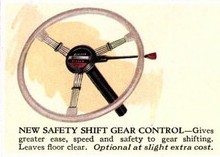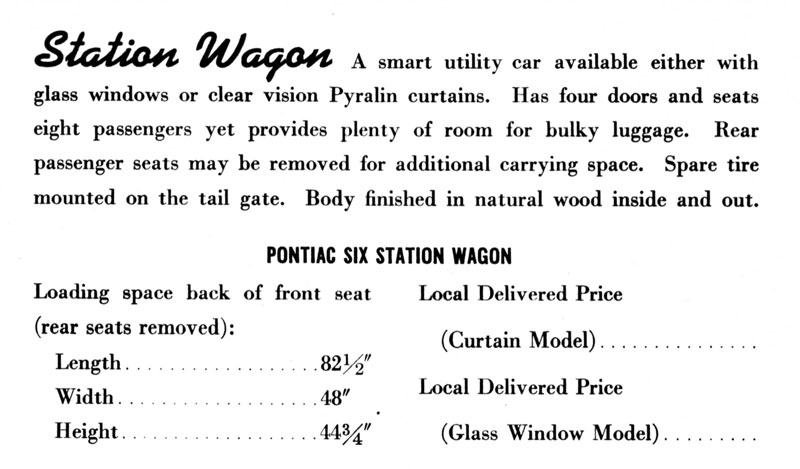
The Pontiac line for 1938 carried over all of the highly successful ’37 models, with a styling facelift. The grille reflected a bold appearance due to 14, equally spaced, straight horizontal bars. The Silver Streaks were comprised of 9 lines that split the grille and ran along the center of the hood toward the windshield, than resumed on the deck lid. The rear Silver Streaks were standard on all closed models for 1938. The numeral 6 or 8 was carried just above the front bumper at the base of the Silver Streak. Both Six and Eight featured an Indian Head centered on the front bumper; but only on the Eight was it flanked by a vertically ribbed trim plate. Six cylinder models had 10 louvers on either side of the hood, complete with bright horizontal trim top and bottom; plus the Pontiac name appearing just behind the grille openings. The Eight cylinder models had 12 louvers, with bright horizontal trim running top, bottom and right across the center of the louvers. The Pontiac name did not appear on either side of the hood. The parking lamps on the Eights were molded into the top of the headlamp buckets The Indian Head hood ornament on the Eight carried a tall “head dress” as compared to the low profile Indian Head on the Six.
The Pontiac line for 1938 was comprised of 17 models in either of 2 series. The 26 series featured 9 models riding on 600x16 tires with a wheelbase of 117 inches, and powered by a 6 cylinder engine. The 28 series had 8 models using 650x16 tires on a 122 inch wheelbase and powered by 8 cylinders. The only model that wasn’t shared between the series was the station wagon. The other major distinction between the series was that any 28 series model was available with dual, side-mounted spare tires at extra cost. The shared models of the line consisted of a business coupe; a sport coupe, equipped with opposing, fold-down “jump” seats; a 2 door Cabriolet with rumble seat; 2 and 4 door slope-back sedans, 2 and 4 door bustle-back, Touring sedans; and the 4 door convertible sedan. The convertible sedan debuted in April of 1937, not long after the introduction station wagon; it was Pontiac’s most expensive model. The open models were available with a choice of 3 colors for the convertible top, either tan blue-grey or black. The color chart provides a wealth of information, and as in the past, some colors could be paired with black enameled fenders, or in body matching Duco. There were also a few metallic colors available this year. Safety-plate glass was made standard equipment is all windows.
The station wagon seated 8 passengers and was finished natural wood inside and out. It could be had with glass side windows or with Pyralin curtains. The rear seats were removable, which left a cargo floor that was 82 ½ inches from back to front, 48 inches wide and 44 ¾ inches high. The spare tire was carried on the tailgate.
There were few mechanical changes for 1938. The most notable was the Safety Shift Gear Control, a $10 option on any ’38 model. It was advertised as the first column-mounted gearshift for the low-priced field; a necessary distinction since Cadillac also offered a column-mounted gearshift this year. It should also be noted that all 1938 Oldsmobiles, plus the Buick Special, could be ordered with the Automatic Safety Transmission; this semi-automatic unit also had the selector lever mounted on the steering column. Buicks and Oldsmobiles fitted with the conventional standard transmission retained the floor mounted shift lever.
The Pontiac line for 1938 was comprised of 17 models in either of 2 series. The 26 series featured 9 models riding on 600x16 tires with a wheelbase of 117 inches, and powered by a 6 cylinder engine. The 28 series had 8 models using 650x16 tires on a 122 inch wheelbase and powered by 8 cylinders. The only model that wasn’t shared between the series was the station wagon. The other major distinction between the series was that any 28 series model was available with dual, side-mounted spare tires at extra cost. The shared models of the line consisted of a business coupe; a sport coupe, equipped with opposing, fold-down “jump” seats; a 2 door Cabriolet with rumble seat; 2 and 4 door slope-back sedans, 2 and 4 door bustle-back, Touring sedans; and the 4 door convertible sedan. The convertible sedan debuted in April of 1937, not long after the introduction station wagon; it was Pontiac’s most expensive model. The open models were available with a choice of 3 colors for the convertible top, either tan blue-grey or black. The color chart provides a wealth of information, and as in the past, some colors could be paired with black enameled fenders, or in body matching Duco. There were also a few metallic colors available this year. Safety-plate glass was made standard equipment is all windows.
The station wagon seated 8 passengers and was finished natural wood inside and out. It could be had with glass side windows or with Pyralin curtains. The rear seats were removable, which left a cargo floor that was 82 ½ inches from back to front, 48 inches wide and 44 ¾ inches high. The spare tire was carried on the tailgate.
There were few mechanical changes for 1938. The most notable was the Safety Shift Gear Control, a $10 option on any ’38 model. It was advertised as the first column-mounted gearshift for the low-priced field; a necessary distinction since Cadillac also offered a column-mounted gearshift this year. It should also be noted that all 1938 Oldsmobiles, plus the Buick Special, could be ordered with the Automatic Safety Transmission; this semi-automatic unit also had the selector lever mounted on the steering column. Buicks and Oldsmobiles fitted with the conventional standard transmission retained the floor mounted shift lever.
Magazine Ad Links: Make it a Rule Outvalues Them All Nine Million Women Drivers
Color Chart Foldout Link to The Old Car Manual Project to see 1938 brochures
Color Chart Foldout Link to The Old Car Manual Project to see 1938 brochures
Pontiac upgraded their transmission with improved synchronizers and a redesigned second gear shift yoke. The clutch linkage was fitted with a toggle action over-center spring that greatly reduced the pressure needed to keep the pedal down. The engines were fitted with a new water pump featuring ball bearings and an improved shaft seal. The most noticeable change under the hood was the installation of the battery, perched atop thside, which kept the cables very short as the starter also mounted on this side of the engine. Six cylinder models were fitted with a starter pedal, while the Eights used a vacuum switch controlled by the accelerator; the last year this feature was used on a Pontiac.
The chassis remained basically unchanged with regard to wheelbase and axle ratios. The front suspension was fitted with improved bearings and the steel wheels now had 10 ventilation slots as compared to the 14 slots of the previous design. The brake system was unchanged, with the exception of a thumb-actuated lock button added to the parking brake lever. This was to prevent the lever from accidentally releasing if bumped.
The instrument panel again featured a horizontal speedometer, above the standard compliment of gauges. An ammeter once again adorned the panel; gone was the warning lamp used in 1937. The Series 26 closed model upholstery choices were either Tan mohair or a mixed wool cloth. The Series 28 closed models offered either Tan mohair or Heatherstone wool twist cloth. The open models of either Series could be had with Taupe whipcord fabric or any one of 6 colors of buffed, crushed-grain Spanish leather. The rear compartment of the 4 door sedans offered arm rests at each end of the seat, complete with ashtrays, assist straps hung just inside each rear door. The rear floor was carpeted and featured a foot rest; a robe cord was attached to the back of the front seat.
The Pontiac accessory list continued to grow for 1938, in addition to the new Safety Shift Gear Control, the Volume Levelizer was a unique device offered in conjunction with the deluxe radio. It consisted of an air vane mounted on the cylinder head adjacent to the thermostat housing. Spring tension held the vane until a speed of approximately 55 to 60 miles per hour was reached, than the rushing air pushed the vane back and automatically increased the volume of the radio. (I have no information as to whether this option was available on any other G.M. automobiles; or if it was available in prior or succeeding model years. Any help would be appreciated.)
Pontiac had record sales in 1937; thanks to a short, but sharp economic decline, 1938 was nearly its worst year ever; only 97,139 automobiles were produced. Production began in September, 1937 and finished on July, 15th 1938. Prices were increasing everywhere, which was at least partially responsible for the economic decline; this was the first year that a standard Pontiac sedan cost more than $1,000. The Deluxe Eight 4 door Touring Sedan had a list price of $1,006. Pontiac buyers could save themselves shipping costs, if they chose to take advantage of the new factory delivery program that was implemented.
Big changes were coming, 1938 was the final model year for the rumble seat; both the 2 and 4 door slope-back sedans; the convertible sedan; and side-mount spare tires, (except station wagons). It was also the last year the engine blocks were cast with the Indian Head on the driver’s side above the starter.
The chassis remained basically unchanged with regard to wheelbase and axle ratios. The front suspension was fitted with improved bearings and the steel wheels now had 10 ventilation slots as compared to the 14 slots of the previous design. The brake system was unchanged, with the exception of a thumb-actuated lock button added to the parking brake lever. This was to prevent the lever from accidentally releasing if bumped.
The instrument panel again featured a horizontal speedometer, above the standard compliment of gauges. An ammeter once again adorned the panel; gone was the warning lamp used in 1937. The Series 26 closed model upholstery choices were either Tan mohair or a mixed wool cloth. The Series 28 closed models offered either Tan mohair or Heatherstone wool twist cloth. The open models of either Series could be had with Taupe whipcord fabric or any one of 6 colors of buffed, crushed-grain Spanish leather. The rear compartment of the 4 door sedans offered arm rests at each end of the seat, complete with ashtrays, assist straps hung just inside each rear door. The rear floor was carpeted and featured a foot rest; a robe cord was attached to the back of the front seat.
The Pontiac accessory list continued to grow for 1938, in addition to the new Safety Shift Gear Control, the Volume Levelizer was a unique device offered in conjunction with the deluxe radio. It consisted of an air vane mounted on the cylinder head adjacent to the thermostat housing. Spring tension held the vane until a speed of approximately 55 to 60 miles per hour was reached, than the rushing air pushed the vane back and automatically increased the volume of the radio. (I have no information as to whether this option was available on any other G.M. automobiles; or if it was available in prior or succeeding model years. Any help would be appreciated.)
Pontiac had record sales in 1937; thanks to a short, but sharp economic decline, 1938 was nearly its worst year ever; only 97,139 automobiles were produced. Production began in September, 1937 and finished on July, 15th 1938. Prices were increasing everywhere, which was at least partially responsible for the economic decline; this was the first year that a standard Pontiac sedan cost more than $1,000. The Deluxe Eight 4 door Touring Sedan had a list price of $1,006. Pontiac buyers could save themselves shipping costs, if they chose to take advantage of the new factory delivery program that was implemented.
Big changes were coming, 1938 was the final model year for the rumble seat; both the 2 and 4 door slope-back sedans; the convertible sedan; and side-mount spare tires, (except station wagons). It was also the last year the engine blocks were cast with the Indian Head on the driver’s side above the starter.



